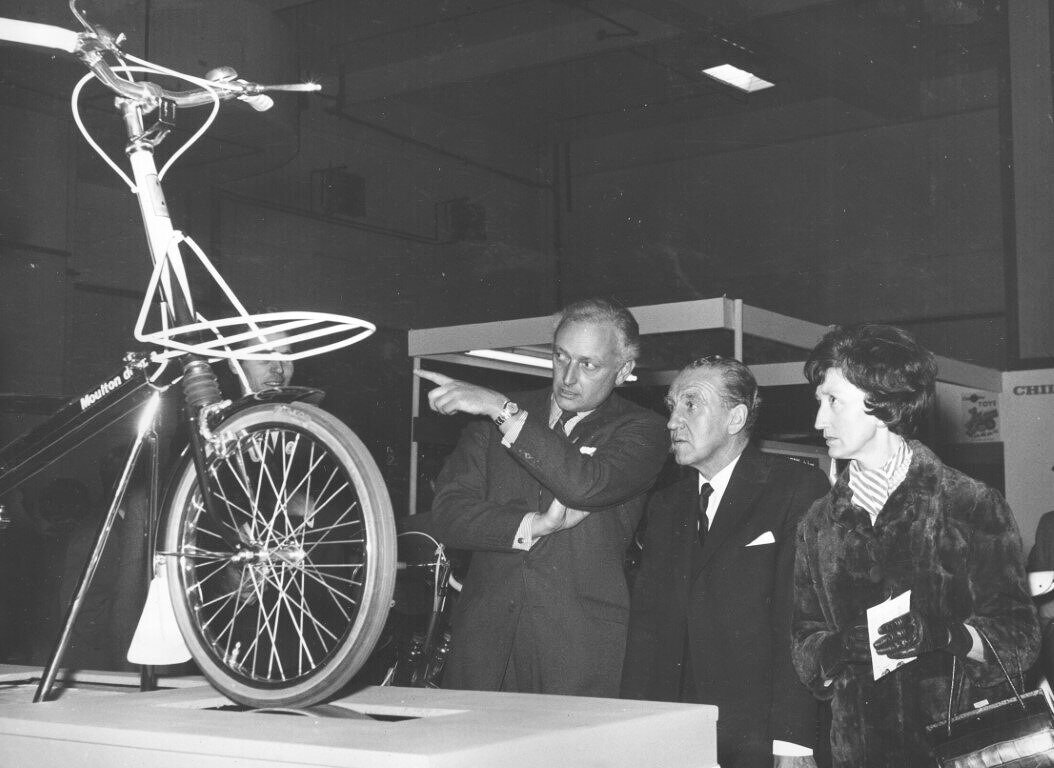THE MINI, ERNEST MARPLES, - AND ALEX MOULTON
As happens so often in research, and in particularly here at The Hall, one discovery leads to another. Indeed, this was one of Alex Moulton’s principles: “innovation breeds further innovation”; in that finding a solution to one problem often leads to the solving of another. In the March 2021 issue of Cooper World, the magazine of the Mini Cooper Register, Mini expert and trustee of the Alex Moulton Charitable Trust Peter Barker tells the story of the very special Mini Cooper made for the then Minister of Transport, the Right Honourable Ernest Marples.
Peter also delves into the role that Marples played in dismantling substantial parts of Britain’s railway network whilst personally benefitting from the huge 1960s road-building programme commissioned by none other than the Minister of Transport, Ernest ‘conflict of interest’ Marples himself.
Perhaps surprisingly, Marples was a cyclist as well as a motorist. He was a member of the Cyclists Touring Club (now Cycling UK) and even went on cycling holidays. Fitting a Moulton bicycle into the boot of a Mini was a problem not resolved by Alex Moulton until 1998; fitting any bicycle into a Mini remains a great challenge to this day, even when the bicycle is dismantled. If all Minis were built like the Marples Special, things would have been much easier.
Pictured right at the Earl’s Court Cycle Show in 1962 are Alex Moulton and Mr. and Mrs. Ernest Marples, with Mr. Moulton explaining the features of the revolutionary new Moulton bicycle, the first full-size small-wheeled bicycle. Also shown (right) is the Cycling Proficiency Scheme Showcase Event at White City in London in 1963. This event, attended by Prince Philip (the Duke of Edinburgh) and Ernest Marples, features demonstrations of how to - and how not to - ride. Also prominent are the two Moulton bicycles: “the new small-wheel bikes are catching on fast.” What this really demonstrates is that Alex Moulton’s marketing team, led by David Duffield, never missed a publicity opportunity. The Duke of Edinburgh became - and remains - a great admirer of the Moulton bicycle. As for Ernest Marples, we’ll let Peter Barker take over the story.
——————————
Many fans of the Mini Cooper will know why 1963 was an important year in the history of our favourite small car, it was of course the year in which the 1071cc Mini Cooper S was launched for sale to the general public in Britain and subsequently around the world. At the 1963 Racing Car Show in Olympia, London and with a new Mini Cooper S on the Cooper Car Co stand, John Cooper persuaded Minister of Transport, Ernest Marples to place an order for one. Marples is said to have replied that he would do so if the car could be modified to carry his golf clubs and wine. BMC had already started work on such a project, the Experimental Department at Longbridge modified a Mini Cooper S as a hatchback and registered the car as 963LOP in early 1964. In 1968 this one-off car was given to Marples when its experimental usage was complete. An interesting car to be sure, but behind this little car was a nationwide struggle concerning Britain’s transport infrastructure.
Since the early 1950s the feeling that Britain’s railways were a thing of the past, a hark back to the early Victorian age of steam railway glory, had been growing within the UK’s various governments. Although Britain’s railways had been nationalised in 1947 little investment was then made in the network which was in a shocking state following hard usage and scant maintenance during wartime. A sprawling national network of tracks previously built and operated by competing private companies and a labour situation that was rooted in Victorian working practices made for an unhappy and positively outdated industry. In 1955 the government finally committed to a modernisation plan for the railways. This included the replacement of all steam locomotives with diesel engines and/or electric traction. It had been realised that a functioning rail system was needed to support British industry, including the car industry, in the delivery of raw materials and goods and the transport of finished products. This plan began to be implemented although it took over ten years for some improvements to take place. At the same time, and rather less publicly, pressure for a review of the railways as a passenger transport system began to build up.
By direct contrast to the railways Britain’s automotive industry was on the rise, very rapidly, during the 1950s. Having taken over many of the shadow factories (new armaments factories built with government money before and during the Second World War) the car companies had modern premises in which to install state of the art manufacturing equipment as they prospered. Standard-Triumph at Canley, Rover at Solihull and Rootes at Ryton on Dunsmore all benefitted from post-war generosity in premises and planning permission as did BMC the largest corporation of them all. It was quickly apparent that cars could earn valuable export currency with which to rebuild Britain, something the railways could not directly achieve. As new models of car and commercial vehicle were designed and began to roll off the production lines of Britain, the power of UK automotive manufacturers represented by the SMMT (Society of Motor Manufacturers and Traders) plus the Road Haulage Association and road building companies rose alongside them. This powerful lobbying group began to press for improvements to Britain’s road network which as it relied in part upon Roman roads and turnpikes dating back centuries was in just as poor state as the railway tracks.
During the late 1950s the Government committed to a programme of road building, starting symbolically with the Preston Bypass, opened in 1958, which eventually became part of the M6. The first full length motorway the M1 opened the following year in 1959 and the roadbuilding programme of new roads, motorways and bypasses has continued to this day. The road building lobby, now named as the British Road Federation, went from strength to strength. In 1959, in a move that with 60 years hindsight does not appear coincidental, Ernest Marples who was a director of the roadbuilding company Marples Ridgway was appointed Minister of Transport. Marples was a flamboyant figure, a showman who enjoyed the publicity his new role brought him and he opened the M1 with a resounding speech welcoming in the new ‘scientific’ age of road transport. Marples proceeded to promote road building at the expense of improving the railways and actually employed his own company to build the Hammersmith Flyover in west London which was opened in 1961. Under pressure from the press and the Attorney General he apparently sold his 80% shareholding in Marples Ridgeway to his wife so that there was no conflict of interest!
In 1963 Marples dealt the UK’s passenger railways a mortal blow. His friend Dr Richard Beeching had been set up as his axe man and published The Beeching Report which identified 5000 miles of railway line and 2363 stations for closure as they were making losses. At a stroke this removed the railway’s ability to move people, particularly on local journeys, and forced them onto the road in motor buses or preferably cars. My grandfather H.P.Barker was a part time member of the British Railways Board at that time and advised the Board on engineering. He was horrified at the extent of the cuts particularly as Beeching had asked him to survey the very lines now being cut on the understanding that he was assessing them for future investment! The deceit of Beeching and Marples became clear when the report was published by which time it was all over for the railways.
At the same time as drastically cutting the railways Marples commissioned another report. This report, called The Buchanan Report or Traffic in Towns, was also published in 1963 and recommended a programme of bypass construction and inner-city ringroads along the line of elevated motorways. Anyone who has visited Coventry or Leeds in the last 50 years will have seen exactly what this does to a city. With more and more cars pouring onto Britain’s roads mostly from UK factories the scene was now set for both the highs and lows of the British motoring industry in the 20th century. Exciting new models such as the Mini Cooper S (1963), E Type Jaguar (1961), Ford Lotus Cortina (1963), Triumph TR4 (1961) and Rover 2000 (1963) took full advantage of Britain’s new speed unlimited motorways and fast trunk roads and earned the UK valuable export currency. On the other hand traffic began to build, as soon as a road opened it filled with cars and this phenomenon carried on throughout later decades.
Nearly 60 years on from that day at the 1963 Racing Car Show it is clear that Ernest Marples and his associates made mistakes. There was a moment when Britain could have pruned its railway network and efficiently modernised the system using a reasonable level of investment, while at the same time building a modern motorway network: but it didn’t. Surely a spectacular missed opportunity? As a footnote it is said that Marples didn’t like the Mini (possibly it was not grand enough for him) and gave it to his wife. As she had also previously received all of those shares in Marples Ridgeway I imagine that she must have been delighted!
© Peter Barker 2021
Thanks to the Mini Cooper Register and Simon Wheatcroft for the use of images.
Earl’s Court 1962: Alex Moulton with Minister of Transport Ernest Marples and his wife. Image courtesy of the Alex Moulton Charitable Trust.
CooperWorld March 2021: UK Transport Policy and the Mini Cooper S.
Ernest Marples’ Mini with full hatchback rear door.
Ernest Marples’ Mini - Almond Green, white roof, chrome trim.
Ernest Marples’ Mini, with plenty of room for golf clubs and cases of wine, and perhaps even bicycles. Why weren’t all Minis like this?





